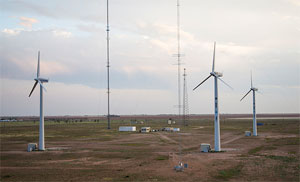A new testing lab for wind technologies is the first to examine how wind turbines interact on a wind farm.
The SWiFT facility (Scaled Wind Farm Technology) is open for business at the Reese Technology Center in Lubbock, Texas.
A collaboration between the Department of Energy’s Sandia National Labs and Texas Tech University, the goal for SWiFT is to facilitate rapid, cost-efficient testing and development of transformative wind energy technology, with specific emphasis on improving wind plant performance.
The facility’s advanced testing and monitoring equipment will help researchers evaluate how larger wind farms can become more productive and thus lowering the cost of wind energy.
This focus moves beyond efforts to maximize the output of a single wind turbine to looking at a wind farm as a whole.

"Some estimates show that 10-40% of wind energy production and revenue is lost due to complex wind plant interaction," notes Jon White of Sandia’s Wind Energy Technologies Department, who serves as technical lead for the project.
"Wind flows into a turbine, and we understand how the turbine responds," says White. "But what we aren’t as clear on is what happens to the wind as it leaves that turbine and moves to the next turbine."
The problem is that multiple turbines create "shadows" and turbines in the shadows have lower output, more turbulence and uneven loads, eventually affecting a wind farm’s longevity and reliability.
Both open-source and proprietary research will be conducted through a partnership between Sandia, Texas Tech’s National Wind Institute, turbine manufacturer Vestas and wind developer Group NIRE.
"This will create a technology accelerator for Vestas, allowing it to bring innovations to market rapidly and cost-effectively," remarks Anurag Gupta, director of rotor systems at Vestas’ Technology R&D center in Houston.
White says the two primary research projects for the next year are testing and evaluating Sandia’s new National Rotor Testbed Project and collecting baseline data for turbine- to- turbine interaction that can be used by the international community to improve wind plant performance.
The National Rotor Testbed Project will provide an open-source rotor design that the wind energy community can collaborate on to bring the best technology to market as rapidly and cost-efficiently as possible.
Last week, we reported that Texas A&M University is opening the world’s largest testing site for solar technologies.
Here’s the SWiFT website:

 Loading...
Loading...
Take a look a aircraft wings, they use winglets to increase lift, resuce turbulance, less shadows. Of course,less turbulance less shadowing, closer spacing…